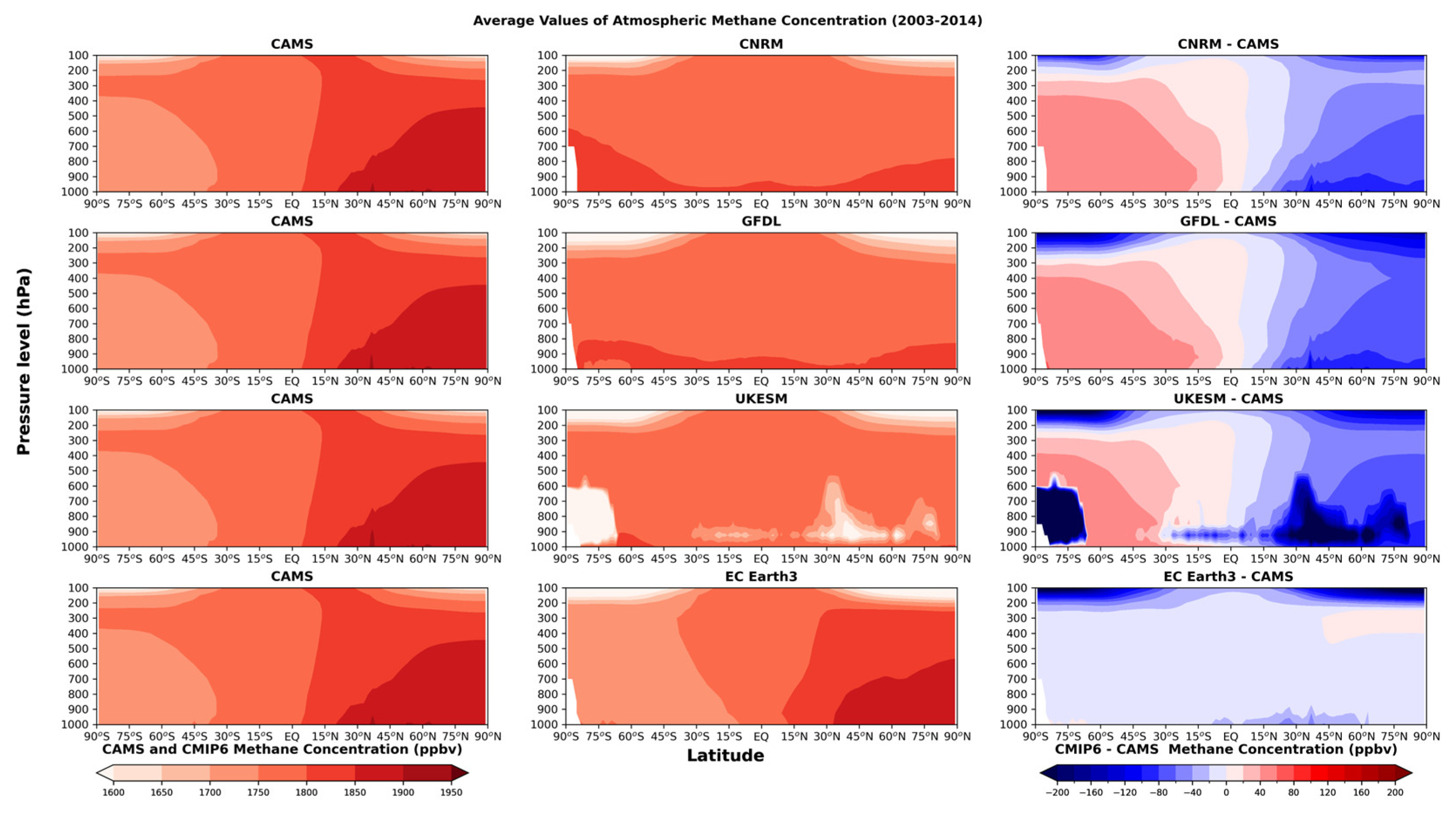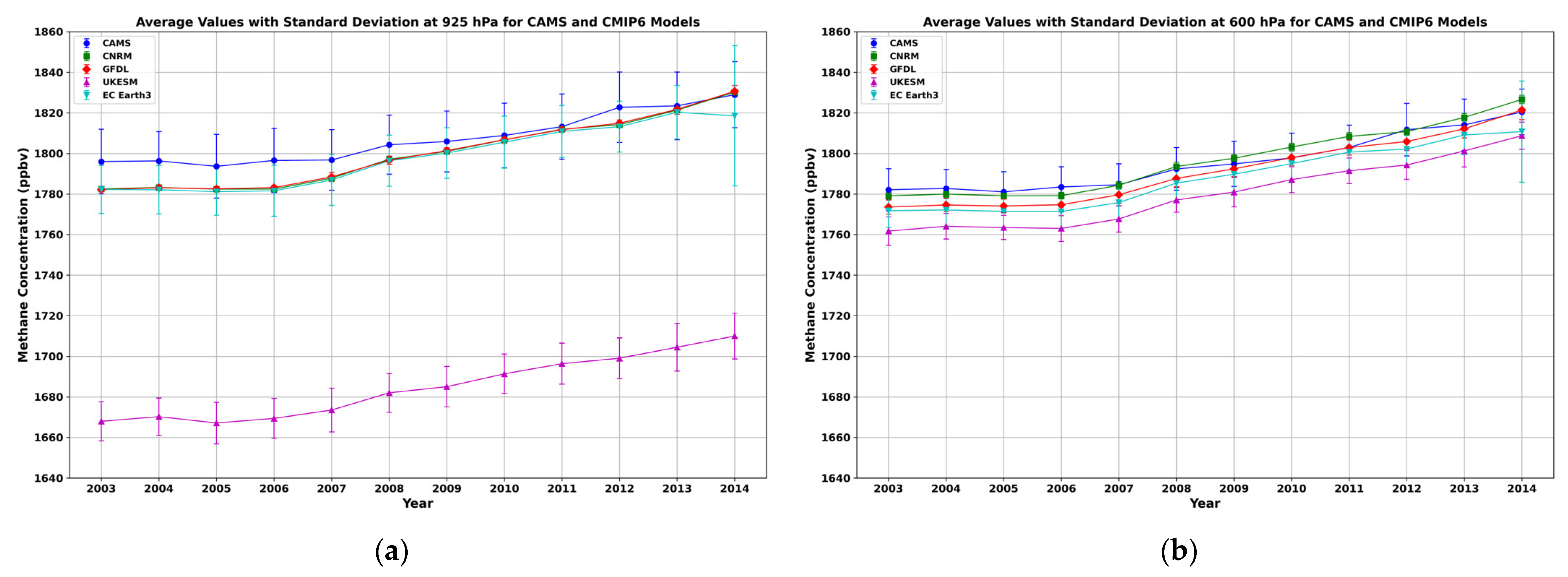Comparison of Methane Concentrations Between CMIP6 Earth System Model Simulations and CAMS Reanalysis Fields †
Abstract
1. Introduction
2. Methods
3. Results
4. Conclusions
Author Contributions
Funding
Institutional Review Board Statement
Informed Consent Statement
Data Availability Statement
Acknowledgments
Conflicts of Interest
References
- Importance of Methane|US EPA. Available online: https://www.epa.gov/gmi/importance-methane (accessed on 25 May 2025).
- Ehhalt, D.H. The atmospheric cycle of methane. Tellus 1974, 26, 58–70. [Google Scholar] [CrossRef]
- Brasseur, G.P.; Solomon, S. Aeronomy of the Middle Atmosphere; Springer: Dordrecht, The Netherlands, 2005; Volume 32. [Google Scholar] [CrossRef]
- le Texier, H.; Solomon, S.; Garcia, R.R. The role of molecular hydrogen and methane oxidation in the water vapour budget of the stratosphere. Q. J. R. Meteorol. Soc. 1988, 114, 281–295. [Google Scholar] [CrossRef]
- Curry, C.L. Modeling the soil consumption of atmospheric methane at the global scale. Glob. Biogeochem. Cycles 2007, 21. [Google Scholar] [CrossRef]
- Dutaur, L.; Verchot, L.V. A global inventory of the soil CH4 sink. Glob. Biogeochem. Cycles 2007, 21, 4013. [Google Scholar] [CrossRef]
- Allan, W.; Struthers, H.; Lowe, D.C. Methane carbon isotope effects caused by atomic chlorine in the marine boundary layer: Global model results compared with Southern Hemisphere measurements. J. Geophys. Res. Atmos. 2007, 112, 4306. [Google Scholar] [CrossRef]
- Thornton, J.A.; Kercher, J.P.; Riedel, T.P.; Wagner, N.L.; Cozic, J.; Holloway, J.S.; Dubé, W.P.; Wolfe, G.M.; Quinn, P.K.; Middlebrook, A.M.; et al. A large atomic chlorine source inferred from mid-continental reactive nitrogen chemistry. Nature 2010, 464, 271–274. [Google Scholar] [CrossRef] [PubMed]
- Collins, J.W.; Lamarque, J.-F.; Schulz, M.; Boucher, O.; Eyring, V.; Hegglin, M.I.; Maycock, A.; Myhre, G.; Prather, M.; Shindell, D.; et al. AerChemMIP: Quantifying the effects of chemistry and aerosols in CMIP6. Geosci. Model Dev. 2017, 10, 585–607. [Google Scholar] [CrossRef]
- Séférian, R.; Nabat, P.; Michou, M.; Saint-Martin, D.; Voldoire, A.; Colin, J.; Decharme, B.; Delire, C.; Berthet, S.; Chevallier, M.; et al. Evaluation of CNRM Earth System Model, CNRM-ESM2-1: Role of Earth System Processes in Present-Day and Future Climate. J. Adv. Model. Earth Syst. 2019, 11, 4182–4227. [Google Scholar] [CrossRef]
- Horowitz, L.W.; Naik, V.; Paulot, F.; Ginoux, P.A.; Dunne, J.P.; Mao, J.; Schnell, J.; Chen, X.; He, J.; John, J.G.; et al. The GFDL Global Atmospheric Chemistry-Climate Model AM4.1: Model Description and Simulation Characteristics. J. Adv. Model. Earth Syst. 2020, 12, e2019MS002032. [Google Scholar] [CrossRef]
- Sellar, A.A.; Jones, C.G.; Mulcahy, J.P.; Tang, Y.; Yool, A.; Wiltshire, A.; O’COnnor, F.M.; Stringer, M.; Hill, R.; Palmieri, J.; et al. UKESM1: Description and Evaluation of the U.K. Earth System Model. J. Adv. Model. Earth Syst. 2019, 11, 4513–4558. [Google Scholar] [CrossRef]
- Van Noije, T.; Bergman, T.; Le Sager, P.; O'DOnnell, D.; Makkonen, R.; Gonçalves-Ageitos, M.; Döscher, R.; Fladrich, U.; von Hardenberg, J.; Keskinen, J.-P.; et al. EC-Earth3-AerChem: A global climate model with interactive aerosols and atmospheric chemistry participating in CMIP6. Geosci. Model Dev. 2021, 14, 5637–5668. [Google Scholar] [CrossRef]
- Griffiths, P.T.; Murray, L.T.; Zeng, G.; Shin, Y.M.; Abraham, N.L.; Archibald, A.T.; Deushi, M.; Emmons, L.K.; Galbally, I.E.; Hassler, B.; et al. Tropospheric ozone in CMIP6 simulations. Atmos. Chem. Phys. 2021, 21, 4187–4218. [Google Scholar] [CrossRef]
- Meinshausen, M.; Vogel, E.; Nauels, A.; Lorbacher, K.; Meinshausen, N.; Etheridge, D.M.; Fraser, P.J.; Montzka, S.A.; Rayner, P.J.; Trudinger, C.M.; et al. Historical greenhouse gas concentrations for climate modelling (CMIP6). Geosci. Model Dev. 2017, 10, 2057–2116. [Google Scholar] [CrossRef]
- Folberth, G.A.; Staniaszek, Z.; Archibald, A.T.; Gedney, N.; Griffiths, P.T.; Jones, C.D.; O’cOnnor, F.M.; Parker, R.J.; Sellar, A.A.; Wiltshire, A. Description and Evaluation of an Emission-Driven and Fully Coupled Methane Cycle in UKESM1. J. Adv. Model. Earth Syst. 2022, 14, e2021MS002982. [Google Scholar] [CrossRef]


Disclaimer/Publisher’s Note: The statements, opinions and data contained in all publications are solely those of the individual author(s) and contributor(s) and not of MDPI and/or the editor(s). MDPI and/or the editor(s) disclaim responsibility for any injury to people or property resulting from any ideas, methods, instructions or products referred to in the content. |
© 2025 by the authors. Licensee MDPI, Basel, Switzerland. This article is an open access article distributed under the terms and conditions of the Creative Commons Attribution (CC BY) license (https://creativecommons.org/licenses/by/4.0/).
Share and Cite
Paschou, S.E.; Kalisoras, A.; Zanis, P. Comparison of Methane Concentrations Between CMIP6 Earth System Model Simulations and CAMS Reanalysis Fields. Environ. Earth Sci. Proc. 2025, 35, 15. https://doi.org/10.3390/eesp2025035015
Paschou SE, Kalisoras A, Zanis P. Comparison of Methane Concentrations Between CMIP6 Earth System Model Simulations and CAMS Reanalysis Fields. Environmental and Earth Sciences Proceedings. 2025; 35(1):15. https://doi.org/10.3390/eesp2025035015
Chicago/Turabian StylePaschou, Sofia Eirini, Alkiviadis Kalisoras, and Prodromos Zanis. 2025. "Comparison of Methane Concentrations Between CMIP6 Earth System Model Simulations and CAMS Reanalysis Fields" Environmental and Earth Sciences Proceedings 35, no. 1: 15. https://doi.org/10.3390/eesp2025035015
APA StylePaschou, S. E., Kalisoras, A., & Zanis, P. (2025). Comparison of Methane Concentrations Between CMIP6 Earth System Model Simulations and CAMS Reanalysis Fields. Environmental and Earth Sciences Proceedings, 35(1), 15. https://doi.org/10.3390/eesp2025035015






